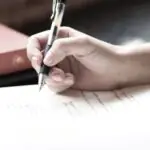
11 Uncommon Punctuation Marks (and How to Use Them)
There’s no doubt about it: punctuation is an integral part of writing. We use it to mark pauses, pose questions, emphasize certain ideas, and clarify meaning. You’ll already be familiar with the usual suspects – periods, commas, exclamation points, question marks, and so on – but did you know there are some weird and wonderful uncommon punctuation marks, too? In this article, we’ll explore how you can use them to spice up your everyday writing.
1. Interrobang
This punctuation mark combines a question mark and exclamation point, and is used to convey incredulity and wonder:
What are you doing‽
It’s more commonly seen as “?!”. Etymologically, “interro” comes from the Latin word “interrogatio”, meaning “questioning”, while “bang” is how printers denote exclamation points.
2. Asterism
In astronomy, an asterism is a group of stars. In punctuation, an asterism is three asterisk marks arranged in a triangle shape (⁂). While an asterisk alone indicates a footnote or the missing letters in swear words, the asterism is used to draw attention to a passage of text, or divide chapters, verses, and other segments in a piece of writing. But since asterisms have never caught on, publishers tend to skip a line, use subheadings, or use three asterisks in a row (***) to divide sections of text.
3. Irony mark
In 1966, a French author named Herve Bazin created the irony mark (as well as a few of the other uncommon punctuation marks in this list). The irony mark resembles the Greek letter “psi” (Ψ), but with a dot below it. The idea is to use it at the start of a sentence to show that the text that follows should be read as ironic.
4. SarcMark
Short for “sarcasm mark”, this uncommon punctuation mark looks like a swirl with a dot in the middle. In 2010, Douglas Sak, the creator of the trademarked SarcMark, was writing an email to a friend. In his attempt to be sarcastic, he realized that most, if not all languages, lacked punctuation to signify sarcasm. These days, people tend to express sarcasm by using an exclamation mark between brackets “(!)”.
5. Snark mark
Much like the SarcMark, the snark mark is used to indicate that a sentence should be understood beyond its literal meaning. You can use the snark mark (a period followed by a tilde) to mock your intended target or make a sarcastic joke:
“Monday again! I’m so excited to go to work.∼”
Unlike the SarcMark, its creator, Choz Cunnigham, chose not to copyright it.
6. Percontation point
In the late 1500s, an English printing worker, Henry Denham, coined the percontation point (a.k.a. a rhetorical question mark). He wanted people to use a reversed question mark at the end of a question to show that it was rhetorical. Unfortunately, it didn’t catch on, as most people tend to know the context of a rhetorical question and, therefore, don’t need telling.
7. Certitude point
If you want to express total conviction in what you’ve written, use a certitude point. We’re back to Bazin, and this time he created an exclamation point with a line through it. Nowadays, people can express their certainty by using all capital letters.
8. Doubt point
While the certitude point represents conviction, ending a sentence with a doubt point shows skepticism and disbelief. It’s a cross between the letter “Z” and a question mark.
9. Exclamation comma and question comma
In 1992, Leonard Storch, Ernst van Haagen, and Sigmund Silber created the exclamation comma and the question comma – an exclamation mark with a comma for a bottom point, and a question mark with a comma for a bottom point, respectively. They are both used to convey someone’s curiosity or excitement at something surprising, without having to end the sentence.
10. Hedera
Another word from the Latin family, “hedera” means “ivy” and was used in Greek and Latin texts to divide paragraphs. Pilcrows (¶) are the modern equivalent.
11. Love point
The last Bazin creation on this list, the love point comprises two mirrored question marks that share a point; put together, they look like a heart. The sweetest one we’ve talked about, this one symbolizes something said with love and affection.
Becoming a Proofreader
Which one of these uncommon punctuation marks do you think you’ll start using? Comment below!
Want to learn more about the ins and outs of punctuation? Try our Becoming a Proofreader course. Sign up for a free trial today to find out more.



Leave a Comment
Your email address will not be published.